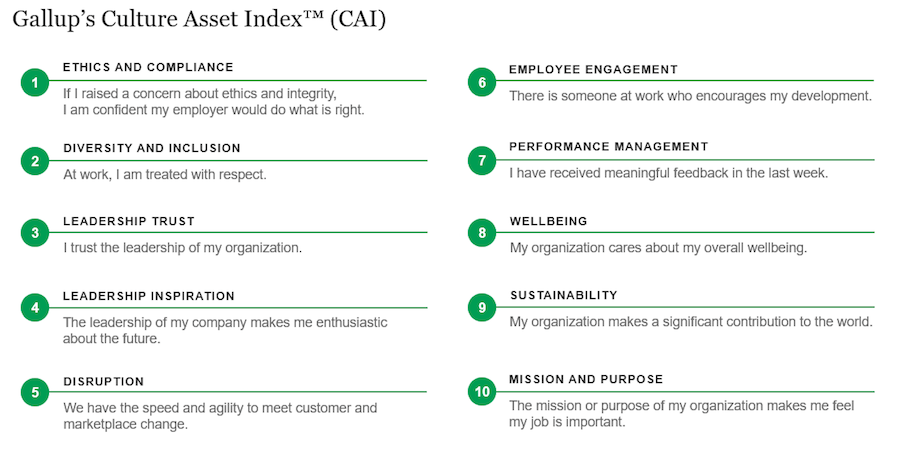Story highlights:
- Psychosocial hazards are eroding employee mental health and wellbeing.
- Psychosocial safety is an organisational culture issue and not just about compliance.
- Organisations must assess cultural risk, hold leaders accountable and support managers.
Register FREE for a Gallup webinar where experts will deep dive into this topic which is reaching crisis point in Australian workplaces.

Australian workplaces are facing a serious mental health crisis. A growing number of employees are exposed to psychosocial hazards that increase their risk of developing work-related psychological injuries.
Mental health conditions contributed an increasing proportion of work-related injuries and illnesses in Australia in 2021-22, accounting for 9 per cent of all serious work-related claims – a rise of nearly 37 per cent since 2017-18. Psychosocial hazards create a toxic workplace environment that erodes employee relationships and provokes harmful behaviours.
The impact of this is devastating. Nearly half of Australia’s workforce experienced workplace bullying, harassment, or discrimination in 2023, according to an Australian Workers Union (AWU) study, resulting in a sharp rise in psychological injury claims.
In addition to the damaging effect on employees, the cost to the Australian economy due to rising psychological and psychosocial injury claims is estimated to be as high as A$39.9 billion annually. Further, lost productivity due to mental health injury claims is more than four times that of all injury and disease claims: Safe Work Australia’s 2024 Psychological health and safety in the workplace report found that the median time lost due to mental health conditions was 34.2 working weeks per serious claim, compared with 8.0 weeks per serious claim for all injuries and diseases.
Of course, toxic workplaces that engender psychosocial hazards exist everywhere, not just in Australia. More than one in five employees globally — 23 per cent — have experienced some form of violence or harassment at work, according to a 2022 ILO-Lloyd’s Register Foundation-Gallup survey.
Psychosocial hazards are facets of the workplace that potentially cause psychological injury and undermine employee mental health. Sadly, these hazards are often part of the day-to-day employee experience and include things such as lack of role clarity, unrealistic job demands, poor manager support, harmful colleague relationships, inadequate reward and recognition or a poor physical environment.
Leaders urgently need to deal with this mounting crisis. They and their organisations have both a duty of care and a vested interest to ensure their workplaces promote psychosocial safety and enhance the engagement and wellbeing of employees. In addition to suppressing harassment and other abusive behaviour, their organisations will benefit from improved employee retention and better collaboration, innovation and productivity.
Four ways leaders can contribute to psychosocially safe workplaces
Governments in Australia and other countries are acting to get in front of this issue by implementing workplace policies aimed at ensuring psychosocial safety in much the same way as physical health and safety.
“Under model work health and safety laws, psychosocial hazards and risks are treated the same as physical hazards and risks,” says Marie Boland, CEO of Safe Work Australia, a government agency that has published its Code of Practice to help identify areas of risk that undermine psychosocial safety in the workplace.
But this is not just a compliance issue: It’s also an organisational culture issue. A healthy culture is essential for both psychosocial safety and performance.
So, what should leaders do?
1. Assess cultural risk
Culture is arguably an organisation’s most valuable asset, and one that is not easily replicated by competitors. Organisations should manage culture like they do other assets by regularly assessing its value, managing risk and ensuring it delivers a satisfactory return. Regularly assessing critical dimensions of an organisation’s culture such as ethics, diversity and inclusion, trust in leadership and wellbeing will reveal areas of cultural strength, as well as highlighting factors that may be early warning signs of psychosocial risks in the workplace.
Gallup’s research on culture has identified 10 thematic dimensions that can be measured and benchmarked, which promote workplace ethics and integrity, employee wellbeing and a culture of inclusion, and are predictive of performance outcomes. Scanning culture across these 10 Culture Asset Index dimensions brings into sharp focus a precise picture of an organisation’s cultural health, and pinpoints where and in which dimensions there are potential risks that need to be addressed.

2. Drive accountability for leaders
Leaders are the de facto owners of their organisation’s culture. Every action they take is watched closely by everyone in the organisation, so they must be role models of psychological safety and demonstrate desired behaviours to managers and front-line employees. They should constantly ask themselves: Are our employees better off psychologically as a result of working here? If not, how can I be a role model for the organisation to ensure they are? Leaders should understand how their own strengths and style are perceived by their teams as they develop, engage and inspire performance.
Leaders’ words and actions carry great significance for the people in their organisation and should clearly illustrate how they live and promote culture and values. For example, if a core value is “ethics and integrity”, leaders need to demonstrate ethical behaviour and integrity in every action and decision they make. They also need to hold themselves and others accountable for adhering to the organisation’s values and upholding psychological safety in the workplace.
3. Equip and support managers
Front-line managers are essential to team engagement, performance and wellbeing. They also play a huge role in establishing an environment of trust and mutual respect within their teams.
Employees need to feel their manager takes an interest in and cares about them – both as a member of the team and as a person. Managers can demonstrate this to their reports by having frequent, ongoing conversations with them about their individual concerns and ambitions. For some managers this comes naturally, but many need training, tools and support to transition from boss to coach.
One practical step that organisations can take is to assist front-line managers to have weekly meaningful conversations with each member of their team. These can start with three simple questions: How are you going? How’s your work going? What support do you need?
When managers take the time to connect regularly by having a one-to-one conversation with everyone on their team, it demonstrates they care and helps establish an environment of mutual trust — an essential element of psychosocial safety. By asking these questions, managers invite team members to share concerns about aspects of their day-to-day experience that are important to them such as workload, goal clarity, colleague relationships, or materials and equipment. This reinforces trust between managers and employees and allows managers to discover potential psychosocial hazards.
4. Create a culture of psychosocial safety — and performance
It’s hard to overstate the impact of culture on psychosocial health and safety, and why it’s essential that organisations assess their culture to identify and mitigate risk factors. But the good news is that a culture of psychosocial safety also benefits organisations through higher employee engagement.
“Proactively managing psychosocial hazards at work not only protects workers,” says Boland. “It also benefits businesses by improving organisational performance and productivity.”

